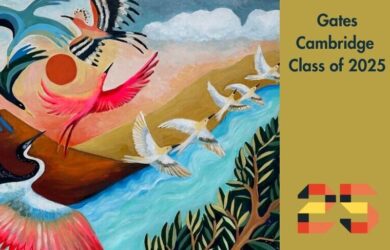Alumni Greg Jordan and Tim O'Connor co-author study on the gorilla genome sequence.
Researchers have completed the genome sequence for the gorilla – the last genus of the living great apes to have its genome decoded. While confirming that our closest relative is the chimpanzee, the team, including two Gates Cambridge alumni, show that much of the human genome more closely resembles the gorilla than it does the chimpanzee genome.
The research is the first time scientists have been able to compare the genomes of all four living great apes: humans, chimpanzees, gorillas and orang-utans. The study provides a unique perspective on human origins and is an important resource for research into human evolution and biology, as well as for gorilla biology and conservation.
“The gorilla genome is important because it sheds light on the time when our ancestors diverged from our closest evolutionary cousins. It also lets us explore the similarities and differences between our genes and those of gorilla, the largest living primate,” says Aylwyn Scally, first author from the Wellcome Trust Sanger Institute. “Using DNA from Kamilah, a female western lowland gorilla, we assembled a gorilla genome sequence and compared it with the genomes of the other great apes. We also sampled DNA sequences from other gorillas in order to explore genetic differences between gorilla species.”
The team, including Gates Cambridge alumni Gregory Jordan, a computational biologist, and zoologist Timothy O’Connor, searched more than 11,000 genes in human, chimpanzee and gorilla for genetic changes important in evolution. Humans and chimpanzees are genetically closest to each other over most of the genome, but the team found many places where this is not the case: 15% of the human genome is closer to the gorilla genome than it is to chimpanzee, and 15% of the chimpanzee genome is closer to the gorilla than human.
In all three species, genes relating to sensory perception, hearing and brain development showed accelerated evolution – and particularly so in humans and gorillas.
“Our most significant findings reveal not only differences between the species reflecting millions of years of evolutionary divergence, but also similarities in parallel changes over time since their common ancestor,” says Dr Chris Tyler-Smith, senior author from the Wellcome Trust Sanger Institute. “We found that gorillas share many parallel genetic changes with humans.”
Jordan and O’Connor [both 2007] conducted the evolutionary analysis of protein-coding genes with two other colleagues from the Department of Zoology.
Jordan, who was funded by a Gates Cambridge scholarship during his PhD at the European Bioinformatics Institute, says: “Our analysis sought to identify genes that had undergone exceptional rates of evolution in the African great apes over the past six to ten million years. Previous studies had found accelerations in the evolution of brain development genes in primates, but what we had not expected was the accelerated evolution of gorilla’s hearing-related genes. Scientists had previously speculated that the accelerated evolution of human hearing genes was linked to the evolution of language. However, our finding that these signals are not unique to humans casts doubt on this.”
The research also illuminates the timing of splits between species. The team found that divergence of gorillas from humans and chimpanzees occurred around ten million years ago. The split between eastern and western gorillas was much more recent, in the last million years or so, and was gradual, although they are now genetically distinct. This split is comparable in some ways to the split between chimpanzees and bonobos, or modern humans and Neanderthals.
“Our research completes the genetic picture for overall comparisons of the great apes,” says Dr Richard Durbin, senior author from the Wellcome Trust Sanger Institute. “After decades of debate, our genetic interpretations are now consistent with the fossil record and provide a way for palaeontologists and geneticists to work within the same framework.
“Our data are the last genetic piece we can gather for this puzzle: there are no other living great ape genera to study.”












